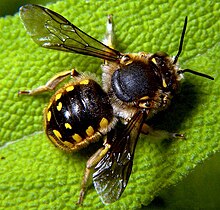| Megachilidae Temporal range: Middle Eocene – recent,
| |
|---|---|

| |
| Male European wool carder bee, Anthidium manicatum | |
| Scientific classification | |
| Domain: | Eukaryota |
| Kingdom: | Animalia |
| Phylum: | Arthropoda |
| Class: | Insecta |
| Order: | Hymenoptera |
| Infraorder: | Aculeata |
| Superfamily: | Apoidea |
| Clade: | Anthophila |
| Family: | Megachilidae |
| Subfamilies | |

Megachilidae is a cosmopolitan family of mostly solitary bees. Characteristic traits of this family are the restriction of their pollen-carrying structure (called a scopa) to the ventral surface of the abdomen (rather than mostly or exclusively on the hind legs as in other bee families), and their typically elongated labrum.[1] Megachilid genera are most commonly known as mason bees and leafcutter bees, reflecting the materials from which they build their nest cells (soil or leaves, respectively); a few collect plant or animal hairs and fibers, and are called carder bees, while others use plant resins in nest construction and are correspondingly called resin bees. All species feed on nectar and pollen, but a few are kleptoparasites (informally called "cuckoo bees"), feeding on pollen collected by other megachilid bees. Parasitic species do not possess scopae. The motion of Megachilidae in the reproductive structures of flowers is energetic and swimming-like; this agitation releases large amounts of pollen.
- ^ C. D. Michener (2007) The Bees of the World, 2nd Edition, pg. 122, Johns Hopkins University Press.